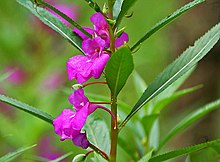Asterids


In the APG II system,[1] for the classification of flowering plants, asterids are a clade of eudicots. That means they are a monophyletic group.[2]
The clade includes 17 orders in the traditional Linnaean system.
Common examples include the forget-me-nots, nightshades, potatoes, eggplants, tomatoes, peppers, tobacco, petunias, morning glory, sweet potato, coffee, lavender, lilac, olive, jasmine, honeysuckle, ash tree, teak, snapdragon, sesame, psyllium, garden sage, and a number of table herbs such as mint, basil, and rosemary.
References[change | change source]
- ↑ The Angiosperm Phylogeny Group classification for the orders and families of flowering plants: APG II.
- ↑ Angiosperm Phylogeny Group 2003. An update of the Angiosperm Phylogeny Group classification for the orders and families of flowering plants: APG II. Botanical Journal of the Linnean Society 141 (4): 399–436. [1]
Wikispecies has information on: Asterids.
